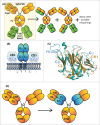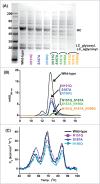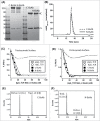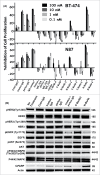Protein design of IgG/TCR chimeras for the co-expression of Fab-like moieties within bispecific antibodies
- PMID: 25611120
- PMCID: PMC4623437
- DOI: 10.1080/19420862.2015.1007826
Protein design of IgG/TCR chimeras for the co-expression of Fab-like moieties within bispecific antibodies
Abstract
Immunoglobulins and T cell receptors (TCRs) share common sequences and structures. With the goal of creating novel bispecific antibodies (BsAbs), we generated chimeric molecules, denoted IgG_TCRs, where the Fv regions of several antibodies were fused to the constant domains of the α/β TCR. Replacing CH1 with Cα and CL with Cβ, respectively, was essential for achieving at least partial heavy chain/light chain assembly. Further optimization of the linker regions between the variable and constant domains, as well as replacement of the large FG loop of Cβ with a canonical β-turn, was necessary to consistently obtain full heavy chain/light chain assembly. The optimized IgG_TCR molecules were evaluated biophysically and shown to maintain the binding properties of their parental antibodies. A few BsAbs were generated by co-expressing native Fabs and IgG_TCR Fabs within the same molecular construct. We demonstrate that the IgG_TCR designs steered each of the light chains within the constructs to specifically pair with their cognate heavy chain counterparts. We did find that even with complete constant domain specificity between the CH1/CL and Cα/Cβ domains of the Fabs, strong variable domain interactions can dominate the pairing specificity and induce some mispairing. Overall, the IgG_TCR designs described here are a first step toward the generation of novel BsAbs that may be directed toward the treatment of multi-faceted and complex diseases.
Keywords: DSC, differential scanning calorimetry; FG loop; HC, heavy chain; Ha, heavy chain containing Ca in place of CH1; Hb, heavy chain containing Cb in place of CH1; LC, light chain; La, heavy chain containing Ca in place of CL; Lb, heavy chain containing Cb in place of CL; RU, resonance units; SDS-PAGE, sodium dodecyl sulfate-polyacrylamide gel electrophoresis; SEC, size exclusion chromatography; SPR, surface plasmon resonance; T cell receptor; TCR, T cell receptor; bispecific antibody; protein chimera; protein design.
Figures






References
-
- Chan AC, Carter PJ. Therapeutic antibodies for autoimmunity and inflammation. Nat Rev Immunol 2010; 10:301-16; PMID:20414204; http://dx.doi.org/10.1038/nri2761 - DOI - PubMed
-
- Fischer N, Leger O. Bispecific antibodies: molecules that enable novel therapeutic strategies. Pathobiology 2007; 74:3-14; PMID:17496428; http://dx.doi.org/10.1159/000101046 - DOI - PubMed
-
- Boersma YL, Chao G, Steiner D, Wittrup KD, Pluckthun A. Bispecific designed ankyrin repeat proteins (DARPins) targeting epidermal growth factor receptor inhibit A431 cell proliferation and receptor recycling. J Biol Chem 2011; 286:41273-85; PMID:21979953; http://dx.doi.org/10.1074/jbc.M111.293266 - DOI - PMC - PubMed
-
- Emanuel SL, Engle LJ, Chao G, Zhu RR, Cao C, Lin Z, Yamniuk AP, Hosbach J, Brown J, Fitzpatrick E, et al. . A fibronectin scaffold approach to bispecific inhibitors of epidermal growth factor receptor and insulin-like growth factor-I receptor. MAbs 2011; 3:38-48; PMID:21099371; http://dx.doi.org/10.4161/mabs.3.1.14168 - DOI - PMC - PubMed
-
- Coloma MJ, Morrison SL. Design and production of novel tetravalent bispecific antibodies. Nat Biotechnol 1997; 15:159-63; PMID:9035142; http://dx.doi.org/10.1038/nbt0297-159 - DOI - PubMed
MeSH terms
Substances
LinkOut - more resources
Full Text Sources
Other Literature Sources
